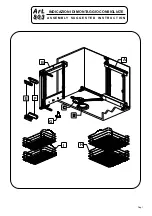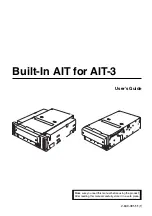
After you define these parameters, the Storage Manager software creates the subsystems, the logical
drives, and the hot spares. The controllers assign subsystem numbers and logical drive numbers as they
are created. After the Storage Manager software creates the initial configuration, you can use the
set
logicalDrive
command to define logical drive labels.
Before you run the
autoConfigure storageSubsystem
command, run the
show storageSubsystem
autoConfigure
command. The latter command returns a list of parameter values that the Storage
Manager software uses to automatically create a storage subsystem. If you would like to change any of
the parameter values, you can do so by entering new values for the parameters when you run the
autoConfigure storageSubsystem
command. If you are satisfied with the parameter values that the
show
storageSubsystem autoConfiguration
command returns, run the
autoConfigure storageSubsystem
command without new parameter values.
The
autoConfigure storageSubsystem
command takes this form:
autoConfigure storageSubsystem
[driveType=(fibre | SATA | SAS)
raidLevel=(0 | 1 | 3 | 5 | 6) |
subsystemWidth=
numberOfDrives
|
subsystemCount=
numberOfLogicalDriveGroups
|
logicalDrivesPersubsystemCount=
numberOfLogicalDrivesPersubsystem
|
hotSpareCount=
numberOfHotSpares
|
segmentSize=
segmentSizeValue
|
cacheReadPrefetch=(TRUE | FALSE)
securityType=(none | capable | enabled)
T10PI=(none|enabled)]
When you use the
autoConfigure storageSubsystem
command, two symbol functions
(
getAutoConfigCandidates
and
createAutoConfig
) are used that let the client retrieve default settings for
the various automatic configuration parameters, change the settings, query what the results of those
changes would be and, finally, apply the desired parameters to create a configuration. The configurability
portion of this feature provides enhancements to the automatic subsystem creation algorithms, which
produce subsystems with improved performance and more information about disk drive and logical
drive attributes so the user can make better choices when configuring logical drives manually.
The
subsystemWidth
parameter defines the number of unassigned disk drives that you want to use for
each new subsystem.
The
subsystemCount
parameter defines the number of new subsystems that you want in the storage
subsystem.
The
LogicalDrivesPersubsystemCount
parameter defines the number of logical drives that you want in
each subsystem.
The
hotSpareCount
parameter defines the number of hot spares that you want in each subsystem.
The
segmentSize
parameter defines the amount of data, in KB, that the controller writes on a single disk
drive in a logical drive before writing data on the next disk drive. The smallest units of storage are data
blocks. A data block stores 512 bytes of data. The size of a segment determines how many data blocks
that it contains. An 8-KB segment holds 16 data blocks. A 64-KB segment holds 128 data blocks.
Important:
For optimal performance in a multiuser database or file system storage environment, set the
segment size to minimize the number of disk drives that are needed to satisfy an I/O request.
Using a single disk drive for a single request leaves other disk drives available to simultaneously service
other requests. Valid segment size values are
8
,
16
,
32
,
64
,
128
,
256
, and
512
.
Note:
If you set the cache block size to
16
, you cannot create a logical drive with a segment size of
8
.
Chapter 4. Configuring a Storage Subsystem
4-33
Summary of Contents for System Storage DS3000
Page 599: ...Appendix A Examples of information returned by the show commands A 3...
Page 601: ...Appendix A Examples of information returned by the show commands A 5...
Page 603: ...Appendix A Examples of information returned by the show commands A 7...
Page 605: ...Appendix A Examples of information returned by the show commands A 9...
Page 607: ...Appendix A Examples of information returned by the show commands A 11...
Page 609: ...Appendix A Examples of information returned by the show commands A 13...
Page 611: ...Appendix A Examples of information returned by the show commands A 15...
Page 623: ...Appendix A Examples of information returned by the show commands A 27...
Page 625: ...Appendix A Examples of information returned by the show commands A 29...
Page 627: ...Appendix A Examples of information returned by the show commands A 31...
Page 651: ......
Page 652: ...Part Number 00W1466 Printed in USA GA32 0961 05 1P P N 00W1466...
















































